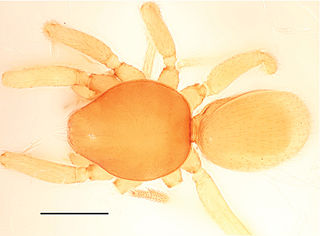
Oonopidae, also known as goblin spiders, is a family of spiders consisting of over 1,600 described species in about 113 genera worldwide, with total species diversity estimated at 2000 to 2500 species. The type genus of the family is OonopsKeyserling, 1835.

Symphytognathidae is a family of spiders with 90 described species in eight genera. They occur in the tropics of Central and South America and the Australian region. Exceptions include Anapistula benoiti, Anapistula caecula, and Symphytognatha imbulunga, found in Africa, Anapistula ishikawai, found in Japan, and Anapistula jerai, found in Southeast Asia.

Mysmenidae is a spider family with about 180 described species in seventeen genera. The family is one of the least well known of the orb-weaving spiders because of their small size and cryptic behaviour. These spiders are found in humid habitats such as among leaf litter and in caves.

Flexicrurum is a genus of spiders from China similar to the genera Althepus and Leclercera. Tong and Li originally placed the genus in Ochyroceratidae Still, Tong later moved it to Psilodercidae. Males are generally smaller than 2 mm, but the size of females is unknown. The name is derived from the Latin flex "curved", and crur "leg", referring to the inner turned palpal tibia of the male. As of 2019 three described species have been found in caves of Hainan Island.

Bannana is a genus of goblin spiders native to Xishuangbanna prefecture, Yunnan Province, China, where it lives in the leaf-litter of tropical rainforest. There are two known species: Bannana crassispina and B. parvula, both described in 2015. Individuals are pale yellow and unpatterned, and range from around 1.0 to 1.8 mm in body length, with females being slightly larger than males. The eyes are reduced or entirely absent. Known only from a nature reserve in Xishuangbanna, Bannana belongs to a group of Asian goblin spiders known as the "Dysderoides complex", that ranges from China to Pakistan and south to Indonesia.
Zoma is a genus of ray spiders that was first described by Michael I. Saaristo in 1996. As of June 2020 it contains three species, found in Japan, China, and on the Seychelles: Z. dibaiyin, Z. fascia, and Z. zoma.
Trilacuna is a genus of goblin spiders native to Southeast Asia, first described by Tong & Li in 2007. They look similar to members of Silhouettella, but males can be distinguished by their large palpal femur, among several other more complicated defining features. The name is a combination of the Latin terms "tri" and "lacuna", referring to the three-branched endites in males and the three-notched labium in females.
Vientianea is a monotypic genus of Laotian goblin spiders containing the single species, Vientianea peterjaegeri. It was first described by Y. F. Tong & S. Q. Li in 2013, and is only found in Laos.
Speleoticus is a spider genus in the family Nesticidae. Its species are found in Japan and China.
Vittatus is a genus of spiders in the family Linyphiidae. It was first described in 2014 by Zhao & Li.
Thaiderces is a genus of spiders from Southeast Asia in the family Psilodercidae, first described in 2017.
Kachinia is a small genus of southeast Asian goblin spiders. It was first described by Y. F. Tong, H. F. Chen and S. J. Liu in 2018, and it has only been found in Myanmar. As of April 2022 it contains only two species: K. mahmolae and K. putao.
Qiongocera is a genus of Southeast Asian araneomorph spiders in the family Psilodercidae, containing the single species, Qiongocera hongjunensis. It was first described by F. Y. Li & S. Q. Li in 2017, and has only been found in China.
Dendroicius is a monotypic genus of east Asian jumping spiders containing the single species, Dendroicius hotaruae. It was first described by Y. J. Lin and S. Q. Li in 2020, who distinguished it from Icius, but did not place it into a subfamily.
Megaeupoa is a small genus of Asian jumping spiders first described by Y. J. Lin and S. Q. Li in 2020. It was not explicitly assigned to a position within the Salticidae, but the name Megaeupoa refers to the "evolutionary relationship" of the genus. As of March 2022 it contains only two species: M. gravelyi and M. yanfengi.
Femorbiona is a genus of Asian sac spiders first described by J. S. Zhang, H. Yu and S. Q. Li in 2021. As of November 2021 it contains only 3 species: F. brachyptera, F. phami, and F. shenzhen.
Paramolotra is a small genus of east Asian goblin spiders. It was first described by W. H. Cheng, D. J. Bian and Y. F. Tong in 2021, and it has only been found in China. As of February 2022 it contains only two species: P. metok and P. pome.
Promolotra is a small genus of southeast Asian goblin spiders. It was first described by Y. F. Tong and S. Q. Li in 2020, and it has only been found in Myanmar. As of March 2022 it contains only two species: P. hponkanrazi and P. shankhaung.
Rhenefictus wandae is a species of jumping spider in the genus Rhenefictus that lives in China and Vietnam. First described in 2021 by Cheng Wang and Shuqiang Li, it was initially allocated to the genus Rhene. In 2022, the species was acknowledged as the same as Rhenefictus tropicus and the two were synonymised under the current name. It is the type species of the genus Rhenefictus. Only the male has been described. The spider is small, with a dark red or dark brown carapace between 2.35 and 2.4 mm long and a brown abdomen between 2.4 and 2.98 mm long. The base of the abdomen is grey-yellow. The spider has a distinctive embolus on its palpal bulb that is coiled and whip-like, terminating in a pointed tip.




